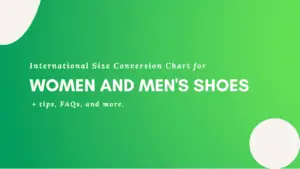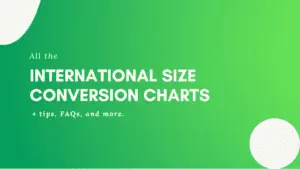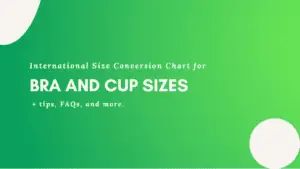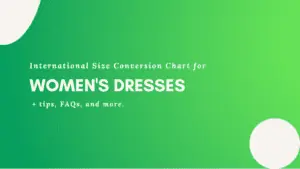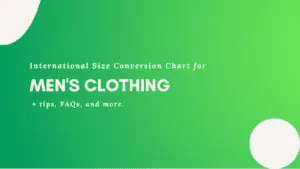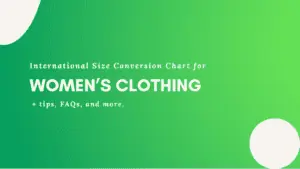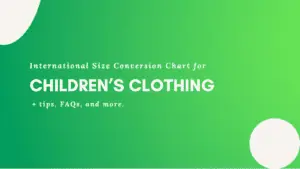Say goodbye to the frustration of buying clothes that don’t fit with this international size conversion chart. Whether you’re shopping online or in-store, below is a US, Europe, and Australian size conversion chart for children of all ages.
International size conversion chart for children’s clothing
These sizes are applicable to both boys and girls as they grow to similar sizes until teenage.
Size conversion chart for tops or T-shirts
| US (age-based) | UK (age-based) | European | Australian |
|---|---|---|---|
| Newborn | 50 cm | Newborn | 00000 |
| 0-3 m | 50-56 cm | 0-3 m | 0000 |
| 3-6 m | 56-62 cm | 3-6 m | 000 |
| 6-9 m | 68-74 cm | 6-9 m | 000 |
| 9-12 m | 74-80 cm | 9-12 m | 00 |
| 12 m | 12 m | 80 cm | 0 |
| 12-18 m | 12-18 m | 80-86 cm | 1 |
| 2T | 18-24 m | 86-92 cm | 2 |
| 3T | 2-3 | 92-98 cm | 3 |
| 4T | 3-4 | 98-104 cm | 4 |
| 5 | 4-5 | 104-110 cm | 5 |
| 6 | 5-6 | 110-116 cm | 6 |
| 7 | 6-7 | 116-122 cm | 7 |
| 8 | 7-8 | 122-128 cm | 8 |
| 9 | 8-9 | 128-134 cm | 9 |
| 10 | 9-10 | 134-140 cm | 10 |
| 11 | 10-11 | 140-146 cm | 11 |
| 12 | 11-12 | 146-152 cm | 12 |
International size conversion chart for pants, jeans, bottoms
| Age | US Size | US Alpha Size | Weight (lbs) | Height (Inches) |
|---|---|---|---|---|
| 2 Years | 2T | 2T | 24-29 | 33-35 |
| 3 Years | 3T | 3T | 29-33 | 35-38 |
| 4 Years | 4T | 4T | 33-37.5 | 39-41 |
| 3-4 Years | 4 | S(4) | 37.5-42 | 42-44 |
| 4-5 Years | 5 | M(5) | 42-46 | 45-47 |
| 5-6 Years | 6 | L(6) | 46-53 | 48-49 |
| 6-7 Years | 7 | XL(7) | 53-58 | 50-52 |
How different countries measure children’s clothing sizes.
- The United States, the UK, and Australia use age-based sizes for children’s clothing. This is typically represented by standard sizes such as newborn, 0-3 months, 3-6 months, and so on. Australian sizes start with 00000 while the child is under 1 year age.
- European countries measure children’s clothing using height-based sizing. This is typically represented by metric measurements such as 50 cm for newborns, 50-56 cm for 0-3 months, 56-62 cm for 3-6 months, and so on.
“The best size chart I have seen on Shopify and the impeccable service will not disappoint you!” – Zee Abayas
Selling children’s clothing online? Try Kiwi’s Size Charts for the perfect fit.
Children’s US size to height and weight measurements
Below is a size chart for reference on how the clothing size pairs with the height and weight of the child.
Children’s Clothing Size Categories
These are the sizing categories you will typically see in the US:
- Baby (Preemie, 0-24 months)
- Toddler (2T-6T)
- Little Kid (4-6X)
- Big Kid or Tween (7-16)
Here’s how the size categories are measured in weight and height.
| Size | Weight | Height |
|---|---|---|
| Preemie | Up to 5 lbs. / Up to 2.3 kg | Up to 17 in. / Up to 43.2 cm |
| Newborn (NB) | 5-8 Ibs. / 2.3-3.6 kg | 17-21 in. / 43.2-53.3 cm |
| 0-3M | 8-12 Ibs. / 3.6-5.4 kg | 21-24 in. / 53.3-61 cm |
| 0-6M | Up to 16 Ibs. / Up to 7.3 kg | 17-26 in. / 43.2-66 cm |
| 3-6M | 12-16 Ibs. / 5.4-7.3 kg | 24-26 in. / 61-66 cm |
| 6-9M | 16-20 Ibs. / 7.3-9.1 kg | 26-28 in. / 66-71.1 cm |
| 12M | 20-24 Ibs. / 9.1-10.9 kg | 28-30 in. / 71.1-76.2 cm |
| 18M | 24-28 Ibs. / 10.9-12.7 kg | 30-32 in. / 76.2-81.3 cm |
| 24M / 2T | 28-32 Ibs. / 12.7-14.5 kg | 32-34 in. / 81.3-86.4 cm |
| 3T | 32-35 Ibs. / 14.5-15.9 kg | 34-38 in. / 86.4-96.5 cm |
| 4T | 35-39 lbs. / 15.9-17.7 kg | 38-40 in. / 96.5-101.6 cm |
| 5T | 39-43 lbs. / 17.7-19.5 kg | 40-44 in. / 101.6-111.8 cm |
This app was super useful for setting up size charts for a wide variety of different product types in our store. Our previous app was tag-based, which was not sustainable for our company. Kiwi uses condition-based product matching which is super easy and logical to set up; now we can leave everything be and new products will automatically have size charts with no extra work.
CKS Online
How to use size conversion charts?
Using these conversion charts is easy.
First, take the size that your child wears in one country and compare it to the sizing chart of another country.
If your child wears a size 12 in the US, you can look at the chart and find the corresponding size in the UK, European, and Australian sizing measurements. In this case, the size 12 in the US would be equivalent to the size 11-12 in the UK, size 146-152 cm in European measurements, and size 12 in Australia.
After finding the corresponding size in the other countries, you can then use that information to help you determine what size clothing to purchase for your child.
Tips for perfectly fitting clothes for your child
- Measure your child: Use a flexible tape measure and verify the height and waist of your child. This needs to be done at regular intervals since kids grow really quickly.
- Check the brand’s size chart: Always check the size chart provided by the clothing manufacturer. Each brand and each style of clothing may fit differently, so it’s important to compare your child’s measurements to the chart to find the right size.
- Consider the room for growth: Children grow quickly, so keep this in mind when shopping for clothes. Consider buying slightly bigger clothes to ensure they last longer.
- Look for adjustable waistbands: Adjustable waistbands can be helpful in getting clothes to fit well, even if your child is between sizes. This can also help to extend the life of the clothes.
- Don’t ignore style: Different styles can have varying sizes or fittings. For example, slim-fitting clothes may run smaller than standard sizes.
How to measure children’s t-shirts?
- Lay your kid’s existing, well-fitting t-shirt flat on a surface.
- Measure from the highest point of the shoulder (where the seam meets the collar) to the bottom of the shirt. This is called the torso length.
- Measure from one end of the sleeve (at the seam) to the other end of the sleeve (at the seam).
- Measure across the chest from armpit to armpit.
- Measure from the top of the shoulder (at the seam) to the end of the cuff.
We’ve covered the steps to measure t-shirts in detail in another article.
FAQs for children’s clothing sizes
Finding it difficult to convert the sizes using the above chart? Here are a few of the common questions asked by our readers about sizing for children’s clothes
What is size 80 in children’s clothing?
Size 80 in children’s clothing is equivalent to 12-18 months in US/UK sizes. The average weight for a child of this size is between 20-28 lbs (9.1 to 12.7 kg) and the height is between 28-32 inches (71.1 to 81.3 cm).
What is size 86 in children’s clothing?
Size 86 in children’s clothing is equivalent to 18-24 months in US/UK sizes. The average weight for a child of this size is between 24-32 lbs (10.9 to 14.5 kg) and the height is between 30-34 inches (76.2 to 86.4 cm).
What is size 90 in children’s clothing?
Size 90 in children’s clothing is equivalent to 2-3 years in US/UK sizes. The average weight for a child of this size is between 16-20 lbs (7.3 to 9.1 kg) and the height is between 26-28 inches (66 to 71.1 cm).
What is size 110 in children’s clothing?
Size 110 in children’s clothing is equivalent to 4-5 years in US/UK sizes. The average weight for a child of this size is between 39-43 lbs (17.7 to 19.5 kg) and the height is between 40-44 inches (101.6 to 111.8 cm).
What is size 128 in children’s clothing?
Size 128 in children’s clothing is equivalent to 7-8 years in US/UK sizes. The average weight for a child of this size is between 28-32 lbs (12.7 to 14.5 kg) and the height is between 32-34 inches (81.3 to 86.4 cm).
What is size 140 in children’s clothing?
Size 140 in children’s clothing is equivalent to 9-10 years in US/UK sizes. The average weight for a child of this size is between 32-35 lbs (14.5 to 15.9 kg) and the height is between 34-38 inches (86.4 to 96.5 cm).
What is the difference between ‘toddler’ and ‘infant’ sizes?
Toddler sizes are generally used for children ages 2-5 and infant sizes are used for children younger than 2 years old. The sizes are typically labeled on the clothing tags, but if not, you can use the above chart to determine the size for each age group.
What is the difference between ‘girls’ and ‘boys’ sizes?
Girl and boy sizes are generally the same, however, boy sizes may be slightly bigger. The sizes are typically labeled on the clothing tags, but if not, you can use the above chart to determine the size for each gender.
Looking for children’s clothing size charts for your store?
While images may work fine, people are using their mobile phones to shop more often than computers. And image size charts can be frustrating to zoom in, scroll around, and find the right size.
Instead, give your customers the perfect-sized clothing the first time. With Kiwi’s interactive size charts with unit conversion so no matter what sizing units your customers prefer, the size chart can deliver.
Kiwi also offers an AI size recommender that asks the buyers a few questions and suggests the best size for them automatically. If you want to reduce returns, offer the perfect size right in the first sale.
Check out other international size conversion charts
- Hat Sizing – International Size Charts
- Women’s and Men’s Shoes – International Size Conversion Chart
- International Size Conversion Charts
- Bra Size – International Size Conversion Charts
- Women’s Dresses – International Size Conversion Chart
- Men’s Clothing – International Size Conversion Chart
- Women’s Clothing – International Size Conversion Chart
- Kids Shoes – International Shoe Size Conversion Chart
- Children’s Clothing – International Size Conversion Chart


